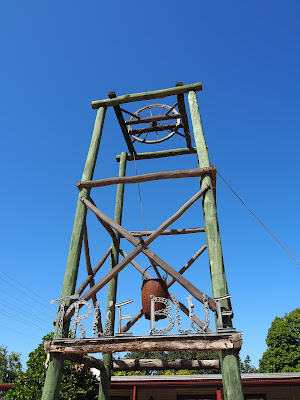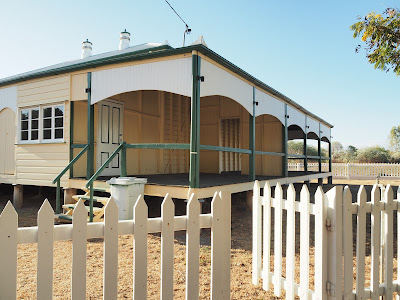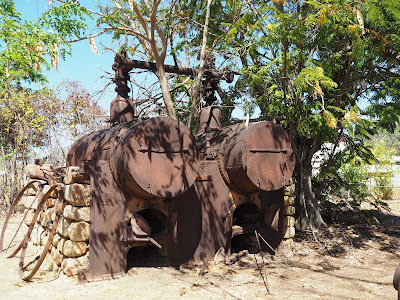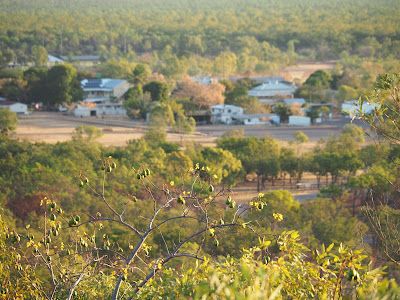Population-wise, the town of Croydon, in north-western Queensland, is a shadow of its former, bustling self. Though it's now home to only a few hundred people, back in 1887, the town's population was 7000. (At its peak, around 1890, Croydon was Queensland's fourth-largest town). The rush to the Croydon goldfield began in late 1885, and thousands flocked there from far and wide seeking to make their fortunes in gold. More than 130 years later, it is the town's historic buildings and mining relics that attract most visitors to Croydon. I'll admit, Croydon had been on my "must visit one day" list for many years, and in 2021, I finally got to explore this fabulous little old gold town. It did not disappoint.
 |
Replica mine headframe outside the True Blue Visitor Information Centre, Croydon.
This centre is home to informative, museum-like displays, as well as outdoor artefacts. It's perhaps the best "information centre" of its kind, outside of the large, regional north Queensland centres.
Photo: Trisha Fielding, 2021. |
We arrived in Croydon on a Sunday, around the middle of the day. Our first stop was lunch at the pub — the Club Hotel. This hotel was built around 1887 and is now the only pub (of the 36 that were operating in that era) that remains in Croydon. It's a charming old hotel that offers food, drinks and accommodation. We ordered some lunch and sat near an open window to eat and enjoy a cold drink.
 |
The Club Hotel, Croydon, NQ.
Photo: Trisha Fielding, 2021. |
The view diagonally across from the pub was of the former Male Ward of the old Croydon Hospital. This building, originally built in 1894, was relocated here from its original location in the 1980s. It's now called Matron Morrow Hall and is used by the community for various purposes.
 |
Former Male Ward of the Croydon Hospital, now known as Matron Morrow Hall.
Photo: Trisha Fielding, 2021. |
There are lots of relics to see in Croydon, that evoke the town's mining heydays, particularly the old machinery you can see on display. The gold on the Croydon goldfield was not alluvial, so you couldn't scratch around near the surface and find gold, like other North Queensland goldfields. The gold was in "reefs", so it had to be mined underground. That's why so much old hefty-looking mining equipment is laying around here. Some of it is in the (open) grounds of the Croydon Shire Council, or at the True Blue Visitor Information Centre (essentially a small museum); but there's also the site of the Iguana Consuls Mine, just a few minutes drive out of town. Most of what you'll see in town has been brought in from old mine sites, so none of it is in situ, which does take something away from the interpretive value of these relics. There is some signage on the displays outside the Visitor Information Centre, which does provide some context, but the machinery in the Council grounds has no signage at all, unfortunately. The exception to this is the heritage-listed Iguana Consuls Mine site, which has mining relics still in situ. This mine is the site of the last deep prospecting shaft sunk on this goldfield — in 1915.
 |
A Langlands ore-crushing battery, (a ten-head 'stamper'), in the grounds of the Croydon Shire Council.
Photo: Trisha Fielding, 2021.
|
 |
Two Langlands boilers, in the grounds of the Croydon Shire Council. These were originally located on the nearby Esmerelda goldfield.
Photo: Trisha Fielding, 2021.
|
 |
Machinery on display outside the True Blue Visitor Information Centre, Croydon.
Photo: Trisha Fielding, 2021. |
 |
Stuart & McKenzie's Union Foundry, established in Croydon in 1891, manufactured machinery for the field.
Photo: Trisha Fielding, 2021. |
The buildings in the town's heritage precinct are all free for the visitor to wander through. Several have very informative displays inside and its worth allowing a couple of hours to have a proper look through them all. The former Town Hall, built around 1890, is a highlight of the streetscape — with its statement tower adorned with a delicate cast iron balustrade. Built of timber and corrugated iron, the building is now used as a movie theatre and dance hall. The stone-pitched gutters on the footpath and the period street lamps add to the authentic feel of this beautifully preserved building.
 |
Former Croydon Town Hall, Samwell Street, Croydon.
Photo: Trisha Fielding, 2021. |
 |
Former Croydon Court House (c. 1887), Samwell Street, Croydon.
Photo: Trisha Fielding, 2021. |
 |
Side view of former Croydon Police Station (c. 1896), Samwell Street, Croydon.
Photo: Trisha Fielding, 2021. |
 |
Front verandah, former Police Sergeant's Residence (c. 1897), Samwell Street, Croydon.
Photo: Trisha Fielding, 2021. |
A fascinating site to visit is the Croydon Chinese Temple and Settlement archaeological dig site, on the fringe of the town. There’s a circular track around the cordoned-off site, with interpretive panels on small posts and each of these elaborates on the life of a Chinese person who lived in Croydon in the gold rush days. According to the Queensland Heritage Register:
Chinese settlers moved into the area soon after gold was found. It has been suggested that their involvement was primarily ... as gardeners, cooks, and carriers. No Chinese held claims at Croydon, although some worked on tribute for other miners. The majority however, worked as market gardeners on 172 acres surveyed in the town plan as garden areas. The Chinese were the chief providers of fresh fruit and vegetables on the goldfields usually growing fruit such as custard apples, mandarins, watermelons and lemons.
... the size and form of the temple was far more substantial than would be expected in an itinerant community. The floor plan shows that the temple was slightly larger than the Atherton temple where the regional Chinese population exceeded 1000. According to a 1986 analysis of the Australian Chinese population after 1881, Sydney, with 3,500 and Melbourne, with 2,400 were the two key centres of population. Research showed that the total Chinese population in all other colonial capitals did not exceed 500 in each place. So Croydon, with an average of 300 people, probably had one of the largest Chinese populations in regional Australia.
Most interestingly, according to historian Dr Jan Wegner, there were also Chinese hard rock miners who invested in mines on the Croydon field. So the Chinese settlers here weren't only market gardeners, storekeepers or cooks.
 |
The remnants of six sandstone bases on the site of a Chinese Temple at Croydon, dating to the 1880s.
Photo: Trisha Fielding, 2021.
|
No visit to a town like Croydon would be complete for me without a visit to the cemetery. The day we visited was a warm one, around 32 degrees celsius, with very low humidity (18%) that made your eyes sting a bit. We waited until late afternoon, to avoid the worst of the heat.  |
Croydon Cemetery.
Photo: Trisha Fielding, 2021.
|
The grass was so crispy and dry here that it made a loud crunching noise under my shoes. No one else was around. We wandered about, looking at the headstones — calling to each other’s attention a particularly interesting headstone or inscription, when each of us found one. It was a quiet, but moving experience. Just us and some raucous cicadas. And the silent presence of the people buried here, who once had such high hopes for their futures — hopes of gold and prosperity. But so many were cut down in their prime. Illness or accident prevailed as causes of death here, more so than old age. I got the sense that not too many grew old here, back then.
 |
Chinese headstone, Croydon Cemetery.
Photo: Trisha Fielding, 2021. |
 |
Headstone, Croydon Cemetery.
Photo: Trisha Fielding, 2021. |
Apart from all the history and heritage attractions in Croydon, there's also a great lookout from which to take in the spectacular sunsets up this way. And a beautiful man-made lake — Lake Belmore, which is less than 4km from town. Built in 1995, Lake Belmore provides Croydon with its town water supply. You can fish and swim here (though I probably wouldn't, given the prominent sign warning of freshwater crocodiles!) and there's also a picnic ground here, complete with well maintained BBQs, under large, covered shelters. We thoroughly enjoyed a beautiful BBQ picnic here one evening, right beside the lake. It was a tranquil spot. And the progression of glorious colours — of powder blue and burnt orange and blood red — as the sun had set and reflected off the lake, was a glorious sight to behold.
 |
Croydon, as seen from Diehm's Lookout. Kapok tree in foreground.
Photo: Trisha Fielding, 2021. |
 |
Sunset over Lake Belmore, Croydon.
Photo: Trisha Fielding, 2021. |
There's something special here for the train buffs too! Croydon is the end of the line for the Normanton to Croydon rail line. This line, built between 1888 and 1891, is a stand-alone rail line — it only ever ran between Croydon and Normanton (from "nowhere to nowhere"). The iconic 'Gulflander' railmotor arrives in Croydon once a week between February and December, weather permitting. But more on this in my next blog — on the port town of Normanton.
 |
The end of line, Croydon.
Photo: Trisha Fielding, 2021. |
Oh, and incidentally, the meals at the Club Hotel were excellent. It's just the usual pub food, but it's as close as you'll get to a home-cooked meal when you're a long way from home. I can recommend the lamb chops with vegetables and gravy. Out the back in the "beer garden" is the best spot to enjoy your dinner!
 |
Out the back of the Club Hotel, Croydon.
Photo: Trisha Fielding, 2021. |
Sources and further reading:
- Chinese Temple and Settlement Site: https://apps.des.qld.gov.au/heritage-register/detail/?id=602079
- Croydon Court House: https://environment.ehp.qld.gov.au/heritage-register/detail/?id=600437
- Croydon Town Hall: https://environment.ehp.qld.gov.au/heritage-register/detail/?id=601653
- Jan Wegner and Jana Kahabka, 'Croydon's historic machinery collection: A case study in the uses and needs of outback heritage machinery collections', Queensland Review, Vol. 25, Issue 2, 2018, pp. 252-266.
- Glenville Pike, Croydon Gold: An Illustrated History of Croydon, North Queensland, Pinevale Publications, Mareeba, 1986.



















No comments:
Post a Comment